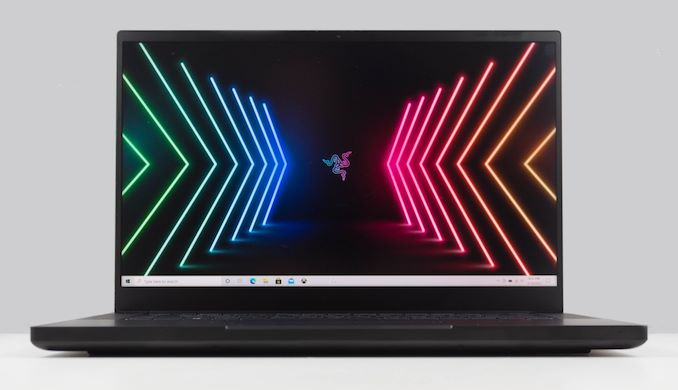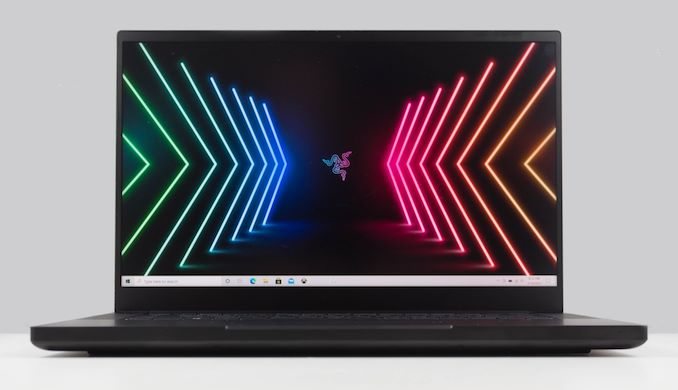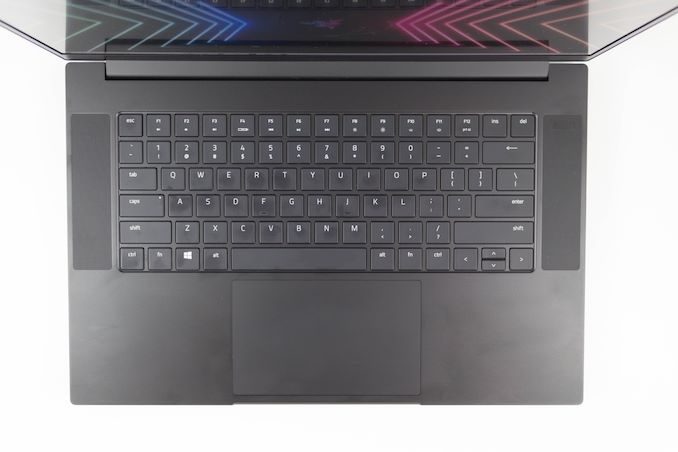The Razer Blade 15 (2021) Review: Amped Up With Ampere
by Brett Howse on March 11, 2021 9:30 AM EST- Posted in
- Laptops
- Gaming
- Razer
- Razer Blade
- Ampere

The original Razer Blade tested the laptop waters for a company more known for gaming peripherals such as keyboards and mice, but the Blade lineup has transformed into a complete gaming laptop suite. Today we are taking a look at our first Razer Blade laptop in a couple of generations, and for 2021, Razer has refreshed with the latest NVIDIA Ampere-based laptop GPUs which should bring about a nice bump in performance at all resolutions.
With Razer Blade laptops in the 13-inch, 15-inch, and 17-inch sizes, Razer offers a laptop that should fit any lifestyle, and the company has now moved into productivity-focused designs such as the Razer Book as well. Razer has always been a premium brand, and although they have dipped their toes into building more affordable offerings, the Blade lineup is certainly at the premium end of the spectrum for pricing.
For their 2021 lineup, Razer is offering two basic models of the Blade 15, each with different options available: the Razer Blade 15 Base model, and the Blade 15 Advanced model. The Base model comes with a Core i7-10750H hex-core processor, 16 GB of DDR4 in dual-channel, and choices of either a NVIDIA GeForce RTX 3060 or RTX 3070 laptop GPU. The Advanced model, in turn, bumps the CPU up to the octo-core i7-10875H, and choices of an RTX 3070, or RTX 3080 with 8/16 GB of VRAM. Each model can accommodate up to 64 GB of memory via SO-DIMMs, and each comes with one M.2 SSD plus room for another.
Each model also offers different display choices. The Base model starts with a 1920x1080 IPS panel with a 144 Hz maximum refresh rate, and sRGB gamut support. For those that want some more pixels in their display, there is also a 2560x1440 165 Hz option with a P3-D65 gamut. The Advanced model offers a 1920x1080 360 Hz sRGB panel as the standard option, bumps the QHD option up a 240 Hz G-SYNC sRGB panel, and also offers a UHD resolution OLED, which caps out at 60 Hz while covering the P3-D65 gamut.
For this review, Razer sent us the Blade 15 Base model with the RTX 3070 laptop GPU and a QHD 165 Hz panel. Razer does support NVIDIA's Optimus technology on the Blade 15, but the newer Advanced Optimus tech can only be found on the QHD version of the Advanced model, meaning there is no G-SYNC support on the rest of the lineup.
| Razer Blade 15 - As Tested: Base Model RTX 3070 QHD $2199.99 USD |
|||||
| Component | Base Model | Advanced Model | |||
| CPU | Intel Core i7-10750H 6 Core / 12 Thread 2.6-5.0 GHz 12 MB Cache, 14nm |
Intel Core i7-10875H 8 Core / 16 Thread 2.3-5.1 GHz 16 MB Cache, 14nm |
|||
| GPU | NVIDIA RTX 3060 6GB Optimus NVIDIA RTX 3070 8GB Optimus |
NVIDIA RTX 3070 8GB Optimus NVIDIA RTX 3080 8GB Optimus NVIDIA RTX 3080 16GB Optimus |
|||
| Memory | 16 GB Dual-Channel DDR4-2933 Maximum memory 64 GB |
16 / 32 GB Dual-Channel DDR4-2933 Maximum memory 64 GB |
|||
| Display | 1920x1080 IPS 144 Hz sRGB 2560x1440 IPS 165 Hz P3 D65 |
1920x1080 IPS 360 Hz sRGB 2560x1440 IPS 240 Hz sRGB G-SYNC 3840x2160 OLED 60 Hz P3 D65 Touch |
|||
| Storage | 512 GB PCIe 3.0 x4 Open M.2 slot |
1 TB PCIe 3.0x4 Open M.2 slot |
|||
| Wireless | Intel Wi-Fi 6 AX201 Bluetooth 5.1 |
Intel Wi-Fi 6E AX210 Bluetooth 5.2 |
|||
| I/O | Thunderbolt 3 USB 3.1 Gen 1 Type-A x 3 USB 3.2 Gen 2 Type-C HDMI 2.1 Gigabit Ethernet |
Thunderbolt 3 with 20V PD USB 3.2 Gen 2 Type-A x 3 USB 3.2 Gen 2 Type-C 20V PD HDMI 2.1 SD Card Reader |
|||
| Battery | 65 Wh 230-Watt AC Adapter |
80 Wh 230-Watt AC Adapter |
|||
| Keyboard | Single-Zone RGB Backlit Chroma anti-ghosting | Per-key RGB powered by Razer Chroma N-Key rollover backlit keyboard | |||
| Webcam | 1 MP / 720p | 1 MP / 720p Windows Hello | |||
| Audio | THX Spatial Audio Stereo speakers 3.5mm output 7.1 via HDMI |
THX Spatial Audio Stereo speakers 3.5mm output 7.1 via HDMI |
|||
| Dimensions | 355 x 235 x 19.9 mm 13.98 x 9.25 x 0.78 inches |
355 x 235 x 16.99 mm 13.98 x 9.25 x 0.67 inches |
|||
| Weight | 2.09 kg / 4.6 lbs | 2.01 kg / 4.4 lbs | |||
| Starting Price (USD) | $1,699.99 | $2,499.99 | |||
There is plenty of connectivity on all of the Blade 15 models, with a single Thunderbolt 3 port on both the Base and Advanced versions, three USB Type-A ports, an additional USB Type-C port, and even an HDMI 2.1 output. The Base model also offers Gigabit Ethernet, whereas the Advanced model switches that up for an SD card reader. The Advances also supports USB Power Delivery 3.0 on both the Thunderbolt 3 and USB Type-C ports.
For wireless, Razer is going with Intel's solutions. The Base model offers the Wi-Fi 6 Intel AX201 with Bluetooth 5.1, and the Advanced bumps that to the latest generation Wi-Fi 6E AX210, which supports Bluetooth 5.2.
The Advanced model also offers a per-key RGB backit keyboard, with of course Razer’s Chroma support, and N-Key rollover. Comparatively, the Base model offers a single-zone RGB backlight. In addition, the Advanced, despite being slightly thinner, offers a much larger battery at 80 Wh, compared to 65 Wh in the Base model, and it also includes an IR webcam for Windows Hello login.
With prices starting at $1699.99 USD for the Base model, and climbing to $3299.99 USD for the OLED Advanced, the Blade 15 covers a wide range of budgets, but most certainly is a premium offering even in the most basic configuration. Let’s dig in and see how it stacks up.
Design
With the move to thinner display bezels, manufacturers have either shrunk the size of their device, or put a larger display in a same-sized chassis. The Razer Blade used to be a 14-inch notebook, but Razer has gone the route of putting a larger display in the same-sized chassis, and we now have the Razer Blade 15. Only 10 mm wider than the 14-inch version used to be, the new model follows Razer’s design ethos, but with a refreshed look and feel compared to the previous 14-inch model.
The smaller display bezels on the laptop, especially on the sides, makes the Razer Blade 15 feel like a proper, modern notebook. The top and bottom bezels are not quite as svelte – leaving some unused space – and normally we'd hope to see the manufacturer move to a taller display to increase the screen to body size ratio even more. That said, as nice as a taller display would be for productivity reasons, on a gaming-focused laptop the 16:9 aspect ratio is still the most widely supported ratio for gaming. Not all games are 100% compatible with aspect ratios outside of 16:9, which can lead to some issues with either letterboxing, or stretching, so Razer’s choice here is the proper one for this market.
Razer builds their chassis out of a CNC aluminum block, which creates one of the most premium looking designs around. The body is very stiff, feels great in the hand, and looks very sharp. The back features the distinctive Razer logo, which lights up in Razer Green. Apart from the logo, the rest of the laptop offers a much more reserved look, unlike some of the garish designs that can be typical of some other gaming-focused laptops. Razer has offered a couple of color choices over the years, but at least for now, the laptop is only available in a glossy black finish. It does look great, but the anodized finish very quickly shows oils from the skin.
Opening the display, the keyboard deck is nicely centered in the chassis. Razer has not chosen to pack in a 10-key pad, which can adversely affect the keyboard layout on devices smaller than 17-inches. The keyboard layout is fairly standard for a Windows laptop, and works very well. The keyboard offers a single-zone RGB backlighting system, which can be customized in the Razer Synapse software, and customers who step up to the Advanced model of the Razer Blade 15 get per-key RGB backlighting. The keys are nicely spaced, but the key feel is quite light, and without a lot of key travel. Keyboards are most certainly a preference item, but I prefer a bit more movement and weight to the key presses. It’s a small knock against an otherwise solid design.
Back in the day, Razer used to offer a trackpad with physical buttons, but they have now moved to the more common clickpad design. The Razer Blade 15’s trackpad works very well, offering a very smooth experience. The Precision touchpad offers the standard configuration options in Windows for multi-finger gesture support and had no issues with detecting the correct gestures. If gaming, you would likely want to connect an external mouse regardless, but otherwise the trackpad worked flawlessly.
The bottom of the laptop includes the cooling intakes, as well as full-width feet which keep the notebook elevated slightly for better cooling and provide a very stable surface.
Overall, the Razer Blade 15 continues Razer’s elegant design, with the modern thin-bezel, high display-to-body ratio, but with the same great construction that the Razer Blade has always achieved. When you compare a premium gaming laptop such as the Razer Blade to a less expensive product from another manufacturer, the physical design is generally one of the most obvious differences. The single-piece CNC milled aluminum chassis is incredibly solid, and the Razer Blade 15 definitely fulfills the premium promise in terms of design.















44 Comments
View All Comments
Ewout - Sunday, March 14, 2021 - link
Ah okay thanks, you think this screen is good enough for photo editing? Just looking for reviews before buying one.Brett Howse - Sunday, March 14, 2021 - link
If your primary goal was editing, then maybe not. If you want to do that as well as gaming, it would be a decent option. The color accuracy is pretty good out of the box, and could be tightened up a bit more with a better ICC profile. You'd need to ensure your photo editing application supported the P3 D65 gamut as well, or everything you edit will be the wrong color if it is assuming sRGB.ghesatcafe - Wednesday, March 17, 2021 - link
Extremely high quality articles from the desired content to the image in the future you can continue to share. Thank you for sharing with everyone, honoring you.MetaCube - Thursday, March 18, 2021 - link
Still using Skylake cores in a 1.7k+ laptop in 2021...